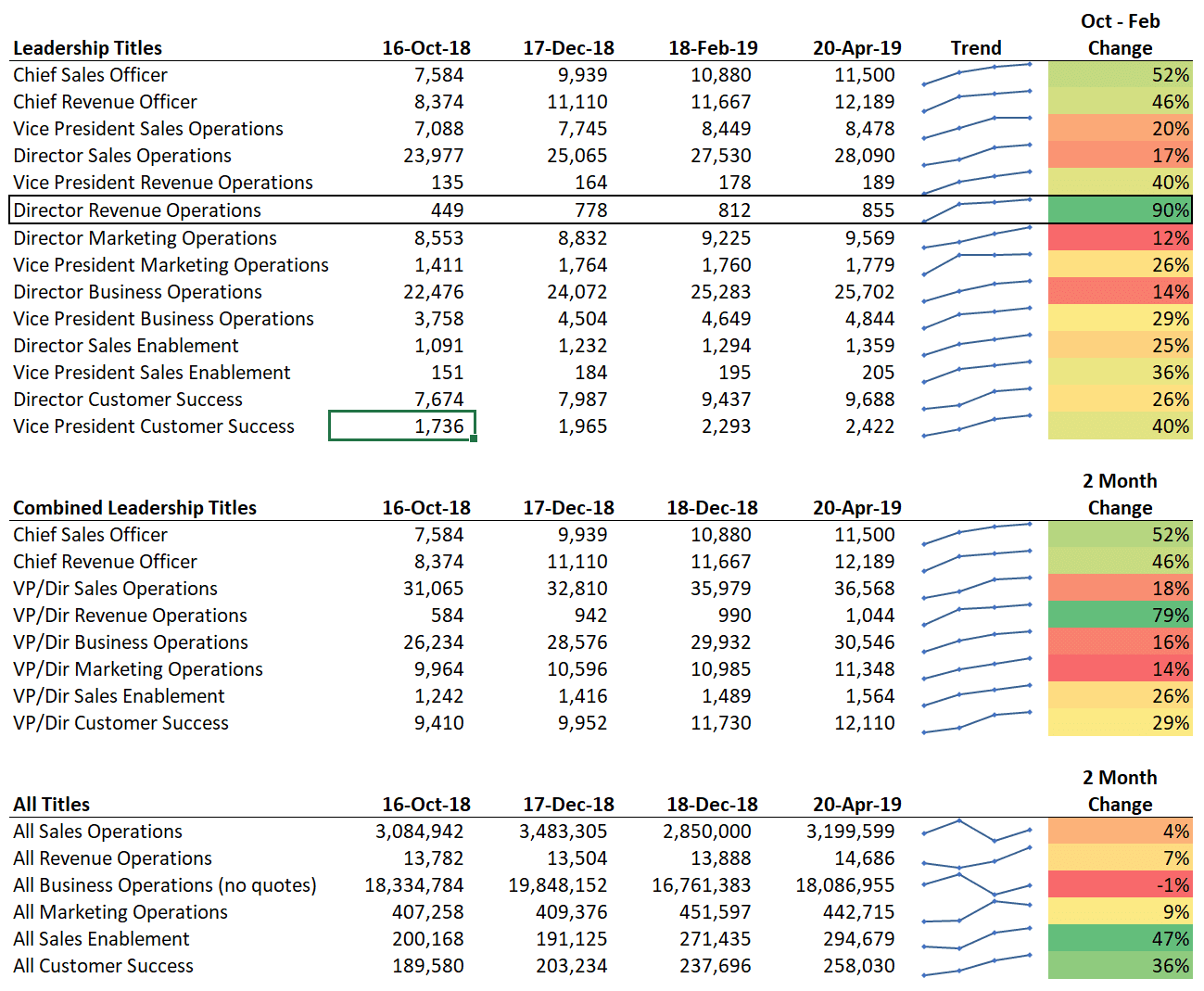RevOps
/rɛvɒps/
nounThe individual role, function and cultural framework to obsessively focus on streamlining operational efficiencies across the revenue cycle.
TL;DR: If you care about revenue and the opportunities ahead to maximize it, you’ve already started thinking “RevOps”.
In our previous post, we’d explained our journey of how we discovered our role in enabling Revenue Operations (aka RevOps).
We weren’t really selling to the Finance and Executive roles people had. We were selling to the “Operational Efficiency” hats they wore!
And it’s not just us. Over the past few months, the term “Revenue Operations” has grown from a silent blog post to a tidal wave of tweets, industry reports and job titles.
But why this sudden paradigm? And how did it get more popular than John Lennon?
According to LinkedIn data analyzed by SiriusDecisions, between October 2018 and April 2019, the number of postings for Director roles in RevOps has grown by a whopping 90%!

Companies that understood the function of Revenue Operations (or RevOps for short), and aligned their teams towards it grew their revenue 19% faster than those who didn’t.
An IDC data report from a couple of years ago adds a different perspective to this trend. Growing businesses, especially in the SaaS space, lose 20-30% of their revenue to operational inefficiencies.
Wait a minute… IDC said you tend to lose 20% of revenue to operational inefficiencies a few years ago. And SiriusDecisions’ recent analysis alludes to a 19% revenue growth by bringing org-wide alignment to revenue operations.
Uncanny.
And yet, like an M.Night Shyamalan movie, it starts making sense.
What do you even mean by “RevOps”?
Because how do you start optimizing for something unless you can clearly articulate what it means and what it should?
InsightSquared, a specialist in marketing and sales analytics, published some of the more popular interpretations that were encapsulated by RevOps practitioners.
One resounding trend you’d notice there (and in most other page-one search results on the topic) is how RevOps is defined as “the merging of sales, marketing, and customer-success operations”.
Perhaps that’s why SalesHacker explains in their State of RevOps 2018 Report, “Revenue Operations arose to unify, measure, analyze, and drive three principal owners of revenue generation. These are the hopelessly siloed bubbles of sales, marketing, and customer success.”
Fair enough. But… something doesn’t quite connect all the dots yet.
Do you just throw marketing, sales and success ops into a room and hope for some magic? Does each ops person now have to build an expertise across the infinite labyrinth of tools across teams? Who runs the sales forecasts? The marketing insights? The churn risk analysis?
Is there more to RevOps than just the sum total of Sales, Marketing, and Success Operations?
The blanket definition RevOps as the “coming together of Sales, Success, and Marketing” does have its merits. But it also seems like a bit of an oversimplification – a vanilla description that hides the multiple layers that actually shape “revenue”.
After all, SaaS companies are about recurring revenue. And MRR, by nature, is everyone’s problem. – Tweet
Product plays a pivotal role in how users onboard, experience, and upgrade. Finance focuses on keeping the revenue “booked” in tune with the revenue realized. In fact, the idea of recurring revenue changes everything, from how you price, to the teams you set up… even the support you deliver.
How then can the operational levers of SaaS recurring revenue be limited to just three functions?
So let’s add more functions to the mix, right? Err… No.
When you bring all the drivers of revenue together, you notice some pieces that cut across functions – the underlying platform of infrastructure, tools, processes, and practices. And this backbone system is what embodies your ideas and strategy into revenue opportunities.
Sure, Sales would like to experiment with a new pricing option.
But who owns the systems and processes to it?
Turns out you’re leaking hard-earned revenue to “processor fees”.
Who dives in to diagnose and fix?
Some of the big ticket customers are churning away within 6 months.
Who arbitrates between Success and Sales to get to the root cause?
Here’s a clue: If it impacts your revenue cycle and the operational leaks and growth opportunities in it, it’s a RevOps problem.
So what exactly is RevOps? The function in your org that obsessively focuses on optimizing your revenue cycle, discovering opportunities, mitigating risks and streamlining operations. Easier still, RevOps is the ultimate guardian of revenue and all operations associated with it. – Tweet
Your revenue operations probably seem to be okay right now. Why should you care?
If I had a dollar for every time I assumed I’d exhausted every revenue efficiency opportunity – I’d have discovered a new revenue channel!
As a business at hyper-growth I know how hard it can be to switch focus from running towards the next big opportunity – to something inwards. Like setting up better processes and efficiencies.
After all, why would you worry about uprooting something that’s working – even if it’s not as smooth as you might imagine when you can just fix today’s problem with duct tape?!
Everything can be fixed with a bit of duct tape. Except for revenue inefficiencies. – Tweet
There are two obvious reasons why you need a dedicated revenue operations function for your SaaS business yesterday:
#1: Inefficiency is the evil by-product of growth
If you’re growing, your process has inefficiencies you MUST plug. That’s just one of the laws of physics (the second law of thermodynamics, to be precise).
As SaaS organizations grow, siloed data and process between revenue generating functions get in the way of understanding the entire story of the business’ operations. With individual operations roles worrying about just their functions in sales, marketing, finance or success, we tend to start missing the forest for the trees.
#2: Inefficiency is usually invisible.
You can’t really notice it unless you’ve been explicitly looking for it in the first place. Or until it’s too late.
Even if you didn’t have a team taking care of sales or marketing ops, your ship sails seemingly smooth. For a while. Then, you’d slow down, as you hit choppy waters – numbers start falling through the cracks despite marketing bringing in the leads, sales closing out record highs, or finance running through books with a magnifying glass. Hard-won revenue seems to be leaking at a hundred different crannies all at once.
The zero moment of truth to realize the need for RevOps isn’t much different. You don’t know until inefficiencies become palpably intolerable. You don’t know until you fall short of your bigger targets.
If you’ve ever felt like you were doing the right things but always seem to be a step behind, it’s probably all that operational mess that’s holding you back. – Tweet
Eventually, inefficiencies in the revenue cycle become palpably intolerable. There’s something holding you back from the bigger targets. You shouldn’t have to firefight with RevOps then. You should have scaled it three quarters before.
Operational inefficiencies strike at every step across the revenue cycle – right from the point of demand generation, and all the way through to retention, upsells, and revenue recognition. And when you put it that way, pretty much every department in your organization that directly or indirectly impacts revenue has scope for driving up RevOps efficiency.
In the next few posts, we’ll be discussing the scope, processes, and objectives of Revenue Operations. Keep an eye on this space over the coming weeks to stay updated.
But until then, here’s something to start chewing. Try to imagine who in your org today is responsible for:
- Measuring & reducing friction across acquisition, sales and upsells.
- Real-time visibility into where your revenue is leaking.
- Identifying, predicting and reducing churn.
- Squeezing most value through every deal in your sales funnel.
- Easing finance processes so you spend less time collating metrics and more time strategizing for the future.
- Asking hard questions about your pricing strategy – how much money are you leaving on the table? And when was the last time you rethought your pricing?
- Streamlining your A/R collections and tightening your revenue recovery process.
- Constantly looking for opportunities at each part of your revenue cycle.
If you have an answer, congratulations! You’ve started thinking RevOps already. Frequently asked questions about RevOps.


